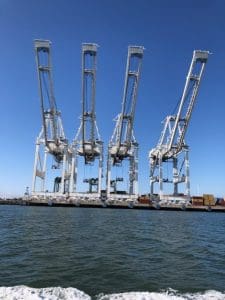As a librarian who specializes in history, I’m always looking for new places and interesting ways to learn Oakland history. Particularly fascinating to me is Oakland’s geography. You can really learn history when you physically put yourself where history happened. To learn more about Oakland’s storied waterfront, I recently joined a boat tour sponsored by Liam O’Donoghue, the popular and widely respected podcaster of "East Bay Yesterday." This two-hour history tour was filled with interesting anecdotes about the region’s environmental, cultural, and industrial history.
Taking off from the Emeryville marina on the fishing boat Pacific Pearl with about 26 passengers, Liam shared a few amazing geological details about the bay. Ten to fifteen thousand years ago the East Bay shoreline we know today was thirty miles west! The San Francisco Bay was just a valley fed by rivers whose headwaters were in the Sierras. Erosion and glaciers carved out the bay that we recognize today. The Ohlone, the earliest inhabitants of the region, lived on an abundance of salmon, mussels, oysters, elk, rabbit, deer, and other fish and game as evidenced by the massive shellmounds that European settlers discovered upon their arrival.
Liam told tales of Emeryville’s colorful history of vice. In the 1870s town officials forbade the establishment of churches within its city limits because they didn’t want anything impeding all the gambling that was going on in town. Earl Warren, who would become not only California’s governor (1943-53), but, later, the Chief Justice of the Supreme Court (1953-1969), made a name for himself as Alameda County District Attorney by fighting crime in Emeryville in the 1920s and 1930s. The East Bay had natural advantages from the start, making settlement in the area easy. Its position on the western edge of the North American continent made it a logical terminus for the Transcontinental Railroad in 1869 which brought tens of thousands of people to the East Bay. It being adjacent to a naturally deep harbor helped in the development of a robust shipping industry.
We headed next to Treasure Island where the Golden Gate International Exposition (GGIE) was held in 1939 and 1940. Designed to commemorate the completion of the Golden Gate and the San Francisco-Oakland Bay bridges, this world’s fair, built on a manmade island connected to the natural island of Yerba Buena, drew ten million people during its run. Lights from its attractions could be seen from miles away. Liam also shared some of the lore of the bay. One story goes that Treasure Island got its name from the gold sediment that deposited in the bay. The island was the place, in the 1850s, where men came to seek and to hide their gold. The Navy took over the island during the buildup to World War II, establishing, among other facilities, a “damage control school” that taught sailors how to deal with radioactive materials!
We learned about the lighthouse on Yerba Buena Island, cruised under the new eastern span of the Bay Bridge, sailed past the massive cargo ships at the Port of Oakland and the storied white mechanical cranes. Passing the site of the old Moore Dry Dock (now Schnitzer Steel Company, a scrap metal operation), it was hard for me to imagine it as the prime East Bay shipbuilding company during World War I. It was this company that taught Henry Kaiser’s outfit how to efficiently build ships during World War II. Heading further down the Oakland estuary we got a glimpse of the houseboats on the Alameda shore, the proposed site of a new Oakland A’s stadium at Howard Terminal, and the new condo village (still under construction) and popular public space at Brooklyn Basin.
This boat trip was a great way to take in some local history, providing new information as well as fresh vantage points to better understand what happened in the past and how it might impact our future. Liam gives tours two or three times a month. If you want to learn more about Oakland and East Bay history, from a seagull’s vantage point, sign up for a tour.
To learn more about the bay and East Bay waterfront, check out these titles from Oakland Public Library:
- The Ohlone Way: Indian life in the San Francisco-Monterey Bay Area / by Malcolm Margolin
- Around the Bay: man-made sites of interest in the San Francisco Bay Region / by Matthew Coolidge
- Back to the Bay: exploring the margins of the San Francisco Bay Region / Center for Land-Use Interpretation
- San Francisco Bay : portrait of an estuary / text by John Hart
- Saving the Bay: the story of San Francisco Bay / a co-production of Ronald M. Blatman, Inc., and KQED/KTEH public television [DVD]



Add a comment to: Oakland’s Waterfront History: a brief tour